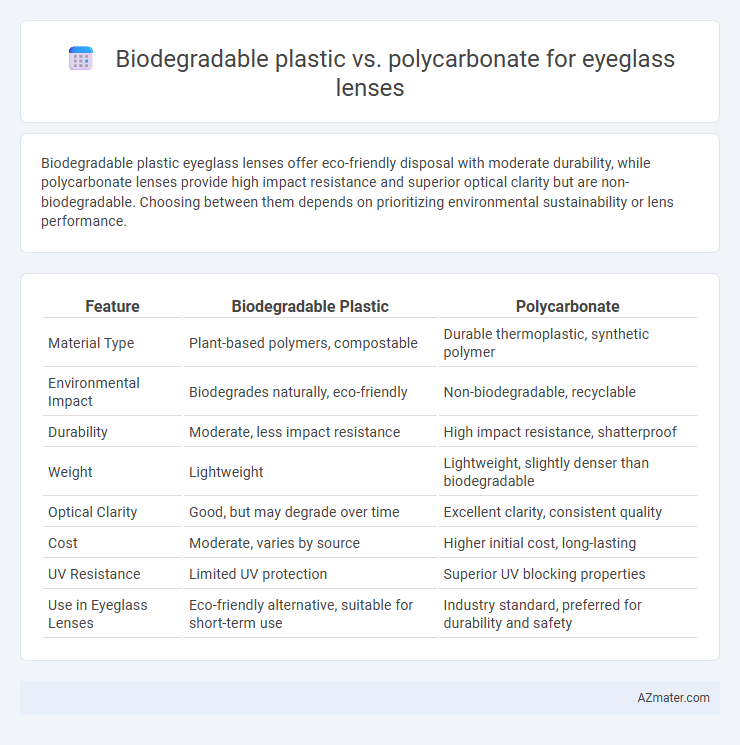Biodegradable plastic eyeglass lenses offer eco-friendly disposal with moderate durability, while polycarbonate lenses provide high impact resistance and superior optical clarity but are non-biodegradable. Choosing between them depends on prioritizing environmental sustainability or lens performance.
Table of Comparison
| Feature | Biodegradable Plastic | Polycarbonate |
|---|---|---|
| Material Type | Plant-based polymers, compostable | Durable thermoplastic, synthetic polymer |
| Environmental Impact | Biodegrades naturally, eco-friendly | Non-biodegradable, recyclable |
| Durability | Moderate, less impact resistance | High impact resistance, shatterproof |
| Weight | Lightweight | Lightweight, slightly denser than biodegradable |
| Optical Clarity | Good, but may degrade over time | Excellent clarity, consistent quality |
| Cost | Moderate, varies by source | Higher initial cost, long-lasting |
| UV Resistance | Limited UV protection | Superior UV blocking properties |
| Use in Eyeglass Lenses | Eco-friendly alternative, suitable for short-term use | Industry standard, preferred for durability and safety |
Introduction to Eyeglass Lens Materials
Eyeglass lens materials primarily include biodegradable plastics and polycarbonate, both valued for their unique optical and physical properties. Biodegradable plastics offer an eco-friendly alternative, decomposing naturally to reduce environmental impact compared to conventional polycarbonate lenses. Polycarbonate lenses remain popular due to their superior impact resistance, lightweight nature, and high optical clarity, making them a standard choice in eyewear manufacturing.
What is Biodegradable Plastic?
Biodegradable plastic for eyeglass lenses refers to polymer materials designed to break down naturally through microbial activity, reducing environmental impact compared to traditional plastics. These plastics are often derived from renewable resources such as cornstarch or polylactic acid (PLA), offering sustainable alternatives to conventional polycarbonate lenses. In contrast, polycarbonate lenses are durable, impact-resistant, and highly transparent but are petroleum-based and non-biodegradable, contributing to long-term plastic waste.
Understanding Polycarbonate Lenses
Polycarbonate lenses offer exceptional impact resistance and optical clarity, making them a preferred choice for eyeglasses requiring durability and lightweight comfort. Unlike biodegradable plastic, which prioritizes environmental sustainability but may lack the same level of scratch resistance and optical precision, polycarbonate lenses provide superior UV protection and edge-to-edge clarity. Understanding the benefits of polycarbonate helps consumers balance performance with environmental considerations when selecting eyeglass lenses.
Environmental Impact Comparison
Biodegradable plastic eyeglass lenses significantly reduce environmental pollution by breaking down naturally in composting conditions, minimizing long-term waste accumulation compared to polycarbonate lenses, which are petroleum-based and persist in landfills for decades. Polycarbonate lenses, while durable and impact-resistant, contribute to plastic pollution and release harmful microplastics during degradation. Choosing biodegradable lenses supports circular economy principles and lowers ecological footprints by enhancing waste management and reducing reliance on fossil fuel-derived materials.
Optical Clarity and Lens Performance
Biodegradable plastic eyeglass lenses offer moderate optical clarity with benefits in environmental sustainability but generally exhibit lower scratch resistance and impact durability compared to polycarbonate lenses. Polycarbonate lenses provide superior optical clarity with high impact resistance and excellent UV protection, making them ideal for active use and safety eyewear. Lens performance in polycarbonate remains consistent over time, whereas biodegradable plastics may degrade faster under environmental exposure, potentially affecting visual quality.
Durability and Scratch Resistance
Polycarbonate eyeglass lenses exhibit superior durability and scratch resistance compared to biodegradable plastic alternatives, making them ideal for long-term use. Polycarbonate's impact resistance prevents lens cracks and breaks, while its hard coating enhances scratch protection, extending lens clarity. Biodegradable plastics tend to be less scratch-resistant and more prone to surface degradation, affecting both durability and visual performance over time.
Weight and Comfort for Wearers
Biodegradable plastic eyeglass lenses are significantly lighter than polycarbonate lenses, enhancing wearer comfort during extended use. The reduced weight minimizes pressure on the nose and ears, making biodegradable lenses ideal for individuals prioritizing lightweight eyewear. While polycarbonate offers high impact resistance, biodegradable plastics provide a comfortable, eco-friendly alternative without compromising everyday wearability.
Cost and Manufacturing Considerations
Biodegradable plastics for eyeglass lenses offer a cost-effective alternative to polycarbonate, often reducing raw material expenses by up to 30% due to renewable resource utilization. Manufacturing biodegradable lenses involves simpler processing techniques and lower energy consumption compared to polycarbonate, which requires high-pressure injection molding and strict temperature controls. Polycarbonate lenses, while more expensive with production costs approximately 40-50% higher, provide superior durability and impact resistance crucial for safety standards in eyewear.
Market Trends and Consumer Preferences
Biodegradable plastics for eyeglass lenses are gaining traction due to rising environmental awareness and demand for sustainable products in the eyewear market. Polycarbonate remains dominant for its superior impact resistance and lightweight properties, favored by consumers prioritizing durability and safety. Market trends indicate a growing niche for eco-friendly lenses, with manufacturers balancing performance and sustainability to meet evolving consumer preferences.
Future Outlook for Sustainable Eyewear
Biodegradable plastics offer a promising future for sustainable eyewear by reducing environmental impact through natural decomposition, while polycarbonate lenses remain popular for durability and impact resistance. Advances in biodegradable polymer technology aim to enhance optical clarity and scratch resistance to compete with polycarbonate's performance. The eyewear industry is increasingly investing in research to develop hybrid materials combining biodegradability with mechanical strength, signaling a shift towards eco-friendly, high-performance lenses in the coming decade.

Infographic: Biodegradable plastic vs Polycarbonate for Eyeglass lens
 azmater.com
azmater.com